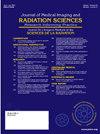放射治疗中MR人员的定义和发展
IF 1.3
Q3 RADIOLOGY, NUCLEAR MEDICINE & MEDICAL IMAGING
Journal of Medical Imaging and Radiation Sciences
Pub Date : 2025-05-01
DOI:10.1016/j.jmir.2025.101958
引用次数: 0
摘要
目的磁共振成像(MR)优越的软组织对比度促使全球放射治疗(RT)部门投资于MR模拟器(MRSIM)和集成MR- linacs (MRL)。在RT部门内维护MR安全增加了操作的复杂性,特别是人员配置。放射学指南将核磁共振人员分为2级:1级(在有核磁共振扫描仪的区域工作的人员)和2级(接受过更广泛培训并通常操作核磁共振技术的人员)。从历史上看,认证磁共振技术人员(RTMR)已被确定为2级磁共振人员,并承担机器操作和磁共振安全的责任。然而,人们已经认识到,鉴于所雇用人员的类型和数量,这种策略可能无法满足复杂的混合MR设置(如RT)的需要。这项工作的目的是为没有获得RTMRI认证的放射治疗师(RTT)确定一条途径,使他们能够承担2级核磁共振人员的职责,包括核磁共振技术的操作和核磁共振安全。方法/流程在2016年实施我们的MR计划程序后,所有未获得RTMR认证的RTMR被确定为1级人员,RTMR被确定为2级人员。虽然1级人员不从事任何核磁共振技术的工作,但他们需要每年完成一次基本的核磁共振安全培训,以确保他们不会在核磁共振环境中对自己或他人构成危险。随着我们的MR车队发展到3个MRSIM (0.5T, 1.5T和3T)和1个MRL,我们探索了将rtt技能提升到2级责任的替代途径。为了确定2级核磁共振人员的要求,进行了环境扫描,以了解其他司法管辖区的方法。两个主要的共同点是教学成分,包括核磁共振物理和核磁共振安全,以及规定的监督核磁共振接触小时数。多伦多大学的核磁共振综合放射治疗(mrrirt)培训项目利用了先进的核磁共振教学知识,但需要建立先决条件的轮转和强制接触时间。结果或利益/挑战将RTMR以外的RTTs确定为2级的好处是,它增加了可以在MR领域工作的受过MR培训的员工的数量。这使得员工日程安排更加灵活,减少了加班的需要。这一转变促进了MRL工作流程中更公平的任务共享,并在整个部门中增加了MR安全知识。一些挑战包括RTMR工作人员感到不被重视,对RTMR遵循新途径的知识基础持怀疑态度,以及整个RTMR社区对安大略省管理实践的立法普遍存在误解。结论/影响由于MRSIM方案的复杂性和安全风险的增加,Level 2在MRL和MRSIM中发挥作用的途径略有不同。在完成我们的内部磁共振成像培训项目后,磁共振成像项目的毕业生必须完成3个月的有监督的磁共振成像时间(即:他们必须与2级RTT合作,然后才能签署。为了让mrrt毕业生轮岗到MRSIM,他们必须首先完成1年的MRL或计划轮岗,以获得MR融合和MR计划的经验。一旦在MRSIM中工作,他们还必须在独立筛查患者之前完成3个月的监督MR时间。迄今为止,已有2个rtt达到了承担MRL 2级责任的标准,MRSIM 2级责任的标准,2级人员增加了约20%。未来的计划是增加这个数字,并正式评估该模型。本文章由计算机程序翻译,如有差异,请以英文原文为准。
Defining and Evolving MR Personnel in Radiation Therapy
Purpose/Aim
The superior soft-tissue contrast of Magnetic Resonance Imaging (MR) has prompted radiation therapy (RT) departments globally to invest in MR simulators (MRSIM) and integrated MR-Linacs (MRL). Maintaining MR safety within RT departments adds a layer of complexity to operations, particularly staffing. Radiology guidelines stratify staff into 2 levels of MR personnel: Level 1 (those who work in an area that has an MR scanner) and Level 2 (those who have more extensive training and typically operate the MR technology). Historically, certified MR technologists (RTMR) have been identified as Level 2 MR personnel and assume responsibility for machine operation and for MR safety. It has been recognized, however, that this strategy may not meet the needs of complex hybrid MR settings such as RT given the type and number of personnel that are employed. The aim of this work was to define a pathway for radiation therapists (RTT) who are not certified as RTMRI to take on the responsibilities of Level 2 MR personnel including operation of MR technology and MR safety.
Methods/Process
Upon implementation of our MR planning program in 2016, all RTTs who were not certified as RTMR were identified as Level 1 personnel and RTMR as Level 2 personnel. Although, Level 1 personnel do not work on any MR technology, they are required to complete basic MR safety training on a yearly basis to ensure that they do not constitute a danger to themselves or others in the MR environment. As our MR fleet grew to 3 MRSIM (0.5T, 1.5T and 3T) and 1 MRL, alternate pathways to upskill RTTs to Level 2 responsibility were explored. In order to define requirements of Level 2 MR personnel, an environmental scan was conducted to understand the approaches in other jurisdictions. The 2 main commonalities were a didactic component that included MR physics and MR safety as well as defined number of supervised MR contact hours. The University of Toronto's MR-integrated Radiation Therapy (MRIRT) training program was leveraged for the advanced MR didactic knowledge but pre-requisite rotations and mandatory contact hours needed to be established.
Results or Benefits/Challenges
The benefits of identifying RTTs other than RTMR as Level 2 is that it increases the pool of MR trained staff who can work in the MR areas. This allows more flexibility in staff scheduling and decreases the need for overtime. The transition has facilitated a more equal sharing of tasks in the MRL workflow and an overall general increase in MR safety knowledge across the department. Some of the challenges include RTMR staff feeling underappreciated, skepticism on knowledge base of RTTs following new pathway and the general misunderstanding of the legislation that governs practice in Ontario by the RT community as a whole.
Conclusions/Impact
The pathway to assume role of Level 2 on MRL and MRSIM are slightly different due to increased complexity of protocols and safety risks in MRSIM. After completing our in-house orientation program for MRL, graduates of the MRIRT program must complete 3 months of supervised MR time (ie. they must be partnered with a Level 2 RTT) before being signed off. In order for an MRIRT graduate to rotate to MRSIM, they must first complete either a 1 year rotation in MRL or planning, to gain experience with MR fusion and MR-only planning. Once working in MRSIM, they must also complete 3 months of supervised MR time before they independently screen patients. To date 2 RTTs have met the criteria to assume Level 2 responsibility in MRL and 2 in MRSIM, an approximately 20% increase in Level 2 staff. Future plans are to increase this number and formally evaluate the model.
求助全文
通过发布文献求助,成功后即可免费获取论文全文。
去求助
来源期刊

Journal of Medical Imaging and Radiation Sciences
RADIOLOGY, NUCLEAR MEDICINE & MEDICAL IMAGING-
CiteScore
2.30
自引率
11.10%
发文量
231
审稿时长
53 days
期刊介绍:
Journal of Medical Imaging and Radiation Sciences is the official peer-reviewed journal of the Canadian Association of Medical Radiation Technologists. This journal is published four times a year and is circulated to approximately 11,000 medical radiation technologists, libraries and radiology departments throughout Canada, the United States and overseas. The Journal publishes articles on recent research, new technology and techniques, professional practices, technologists viewpoints as well as relevant book reviews.
 求助内容:
求助内容: 应助结果提醒方式:
应助结果提醒方式:


